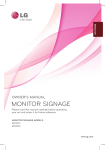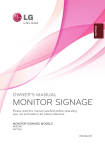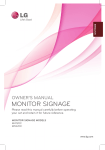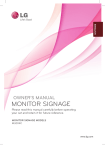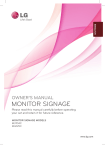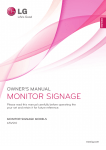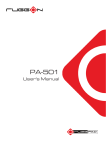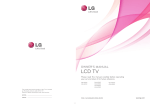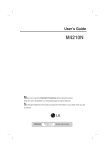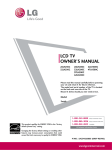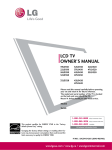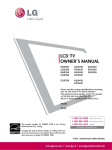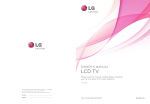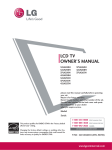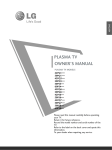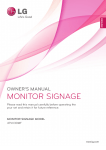Download LG 47VT30MS-B touch screen monitor
Transcript
ENGLISH OWNER’S MANUAL MONITOR SIGNAGE Please read this manual carefully before operating your set and retain it for future reference. MONITOR SIGNAGE MODELS 47VT30 www.lg.com Table of Contents Licenses Accessories 3 4 Separate Purchase .............................................................................................................4 To Install in Portrait Orientation Using the Remote Control Name and Function of the Parts 5 6 8 Rear View...............................................................................................................................8 Connecting to External Devices 9 When Connecting to your PC.............................................................................................9 When Using the LAN...........................................................................................................11 Daisy Chain Monitors..........................................................................................................12 VESA FDMI Wall Mounting..................................................................................................13 Video Input............................................................................................................................14 Component Input (480i/480p/576i/576p/720p/1080i/1080p)...........................................15 HDMI Input (480p/576p/720p/1080i/1080p).......................................................................16 User Menus 17 Screen Adjustment Options...............................................................................................17 OSD Menu ............................................................................................................................19 How to Adjust the Screen Automatically..........................................................................20 How to Adjust the OSD (On Screen Display) Screen.....................................................20 Adjusting Screen Color.......................................................................................................21 Adjusting the Audio Function............................................................................................27 Adjusting the Timer Function.............................................................................................28 Selecting the Options .........................................................................................................29 Adjusts the USB Options....................................................................................................31 Cautions When Using the Touch Screen 45 Using the Touch Screen (Windows 7)...............................................................................46 Using the Touch Screen (Windows XP)............................................................................47 Troubleshooting Specifications Controlling the Multiple Product IR Codes 2 49 56 A1 A26 Licenses Supported licenses may differ by model. For more information of the licenses, visit www.lg.com. The terms HDMI and HDMI High-Definition Multimedia Interface, and the HDMI logo are trademarks or registered trademarks of HDMI Licensing LLC in the United States and other countries. ABOUT DIVX VIDEO: DivX® is a digital video format created by DivX, LLC, a subsidiary of Rovi Corporation. This is an official DivX Certified® device that plays DivX video. Visit divx. com for more information and software tools to convert your files into DivX videos. ABOUT DIVX VIDEO-ON-DEMAND: This DivX Certified® device must be registered in order to play purchased DivX Video-on-Demand (VOD) movies. To obtain your registration code, locate the DivX VOD section in your device setup menu. Go to vod.divx.com for more information on how to complete your registration. DivX Certified® to play DivX® video, including premium content. DivX®, DivX Certified® and associated logos are trademarks of Rovi Corporation or its subsidiaries and are used under license. Covered by one or more of the following U.S. patents: 7,295,673; 7,460,668; 7,515,710; 7,519,274 Manufactured under license from Dolby Laboratories. Dolby and the double-D symbol are trademarks of Dolby Laboratories. 3 Accessories Accessories Thank you for your purchase. Please check the product as well as the accessories shown below. ❖ Note that the accessories may look different from those shown here. Remote Control / Batteries Power Cable D-Sub Signal Cable USB Cable CD-ROM/ Cards Separate Purchase Without prior notice, optional accessories are subject to change to improve the performance of the product, and new accessories may be added. ❖ Optional accessories (purchased separately) may vary depending on the model. ❖ Note that optional accessories may look different from those shown here. ❖ You can obtain additional accessories from most electronics stores. NC2100/ NA2000/ NA2100 Kit NC2100 NA2000 NA2100 Screws (2) CD-ROM/ Cards 4 To Install in Portrait Orientation - Only on some models. "To install in a portrait orientation, rotate the screen 90 degrees clockwise." Note • When using the wall mounting bracket or the portrait scene mode, the opening can be covered by the stand hole cover. 5 Using the Remote Control Name of the Remote Control Buttons 1 2 3 ENERGY MONITOR INPUT OFF ON .,! GHI 1/a/A SAVING TUV -*# CLEAR ABC JKL PSM 7 MNO P BRIGHT A NESS G E MENU AUTO S.MENU Number and Alphabet Buttons - Type numbers and alphabets. 4 1/a/A Button - Selects the number and alphabet. (SuperSign input only) 5 Volume Up/Down Button - Adjusts the volume. 6 PSM Button - Selects the Picture Status Mode. 7 MUTE Button - Switches the sound on or off. 8 MENU Button - Selects a menu. - Clears all on-screen displays and returns to Monitor viewing from any menu. 9 Up/Down/Left/Right Buttons - Allows you to navigate the on-screen menus and adjust the system settings to your preference. OK 10 13 3 WXYZ MUTE 9 12 Monitor On / Off Button - Turn off the monitor and then turn it back on. DEF ARC 6 11 2 MARK 5 8 Power On / Off Button - Switches the set on from standby or off to standby. POWER PQRS 4 1 BACK TILE ID ON OFF EXIT 10 OK Button - Accepts your selection or displays the current mode. 11 BACK Button - Allows the user to move return one step in an interactive application. 12 ID ON/OFF Button - When the number of input ID is equal to the number of ID Mode, you can control the monitor which you want in the multi display condition. 13 USB Menu Control Buttons - Adjust the USB menu(Photo List, Music List and Movie List ). 6 Using the Remote Control POWER 14 ENERGY MONITOR INPUT 15 OFF ON .,! GHI PQRS 1/a/A Energy Saving Button - Adjust the Energy Saving mode of the SET. 15 INPUT Select Button If you press the button once, the following Input Signal Window will appear. Select the signal type you want using the < > button. SAVING TUV -*# CLEAR ABC JKL DEF Input List MNO AV WXYZ 16 ARC PSM P BRIGHT A NESS G 20 TILE ID ON EXIT 21 18 Brightness Key - Adjust the resolution and brightness by pressing the Up and Down buttons on the remote control. - In USB mode, the OSD menu has the Page function to move to the next file list. 19 AUTO Button - Automatically adjusts picture position and minimizes image instability.(RGB input only) 20 S.MENU Button (SuperSign Menu Key) - Selects the SuperSign OSD Menu. (SuperSign input only) 21 EXIT Button - Clears all on-screen displays and returns to monitor viewing from any menu. 22 TILE Button - Selects the TILE Mode. - This button selection is not applicable. 22 OFF SuperSign ARC Button - Selects the Aspect Ratio Mode. MARK - Selects a specific file in the USB mode. OK BACK HDMI/DVI 17 19 S.MENU RGB Clear Button - Delete the numbers and alphabets you typed.(SuperSign input only) E MUTE AUTO 18 Component 16 17 MARK MENU 14 Inserting batteries into remote control AAA Type 1. Slide off the battery cover. 2. Insert the batteries with correct polarity ( + / - ). 3. Close the battery cover. 4. To remove the batteries, perform the installation actions in reverse. • Dispose of used batteries in the recycle bin to prevent environmental pollution. 7 Name and Function of the Parts * The product image in the user's guide could be different from the actual image. Rear View 1 2 3 4 5 6 7 8 1 Power Connector Connect the power cord 2 RS-232C Serial Ports 3 RGB, HDMI/DVI Ports HDMI Supports High Definition input and HDCP (High-bandwidth Digital Content Protection). Some devices require HDCP in order to display HD signals. 4 PC Sound Jack Connect an audio cable to the *LINE OUT jack of the PC sound card. 5 Component, AV Ports 6 USB Port 7 LAN Port 8 Speaker Ports 9 Touch Port Connects the monitor and the PC with USB cable. * LINE OUT A terminal used to connect to the speaker including a built-in amplifier (Amp). Make sure that the connecting terminal of the PC sound card is checked before connecting. If the Audio Out of PC sound card has only Speaker Out, reduce the PC volume. If the Audio Out of the PC sound card supports both Speaker Out and Line Out, convert to Line Out using the card jumper of the program (Refer to the Sound Card Manual). 8 Connecting to External Devices When Connecting to your PC 1 First of all, see if the computer, product and the peripherals are turned off. Then, connect the signal input cable. A. B. When connecting with the D-Sub signal input cable. When connecting with the HDMI-DVI signal input cable (not included). * When HDMI PC is used, a compatiblity problem might occur. A. PC Rear back of the set MAC PC/MAC Macintosh Adapter (not included) Use the standard Macintosh adapter since an incompatible adapter is available in the market. (Different signaling system) B. (not included) Rear back of the set PC * User must use shielded signal interface cables (D-sub 15 pin cable, HDMI-DVI cable) with ferrite cores to maintain standard compliance for the product. 2 Connect the Audio cable. (not included) Rear back of the set 3 PC Connect the USB cable. Rear side of the product Note PC • The monitor’s USB terminal supports USB 2.0 and full speed (12Mbps). 9 Connecting to External Devices 4 Connect the power cord. Rear back of the set 5 1. Turn on power by pressing the power button on the product. On/Off button 2. 6 Turn on the PC. Select an input signal. Press the INPUT button on the remote control to select the input signal. INPUT → → OK Or, press INPUT on the bottom of the set. INPUT →◄ ► → AUTO/SET A. When connecting with a D-Sub signal input cable. • Select RGB : 15-pin D-Sub analog signal. Input List AV B. Component RGB HDMI/DVI SuperSign When connecting with a HDMI-DVI signal input cable and HDMI Signal Cable. • Select HDMI/DVI : DVI Digital signal or HDMI Digital signal. Input List AV Note Component RGB HDMI/DVI SuperSign • How to connect to two computers. Connect the signal cables (HDMI-DVI and D-Sub) to each computer. Press the INPUT button on the remote control to select the computer to use. • Directly connect to a grounded power outlet on the wall or a power bar with a ground wire. 10 Connecting to External Devices When Using the LAN 1 Connect the LAN cable as shown in the below figure . A. B. Connect PC to Monitor directly. Using a router(Switch) LAN LAN Switch Product Product PC PC C. Using the Internet. Network LAN Network Product 2 PC Network Connect the LAN cable and install the eZ-Net Manager program on the CD-ROM. For more information about the program, please refer to eZ-Net Guide in the enclosed CD-ROM. Note • Using LAN establishes communication between your PC and the monitor and enables to use the OSD menus on the PC as well as on the monitor. 11 Connecting to External Devices Daisy Chain Monitors A. When using RGB input To use different products connected to each other Connect one end of the signal input cable (15-pin D-Sub Signal Cable) to the RGB OUT connector of product 1 and connect the other end to the RGB IN connector of other products. 15-pin D-Sub Signal Cable PC PC Product 1 B. Product 2 Product 3 Product 4 When using AV input Audio Cable (not included) Video BNC Cable (not included) Product 1 Note Product 2 Product 3 • The number of monitors that can be connected to one output may vary depending on signal status and cable loss. If the signal status is good, and there is no cable loss, it is possible to connect up to 9 monitors. If you want to connect more than this number of monitors, it is recommended to use an amplified splitter or a distributor. 12 Connecting to External Devices VESA FDMI Wall Mounting This product supports a VESA FDMI compliant mounting interface. These mounts are purchased separately and not available from LG. Refer to the instructions included with wall mount for more info. Kensington Security Slot The Set is equipped with a kensington Security System connector on the back panel. The cable and lock are available separate and are not sold by LG. For more info, visit http://www.kensington. com, the internet home page of the Kensington company. Note • T here is a switch on the lower side of the back. You can set the switch to "On" before connecting a power cord to make it more convenient for use. 13 Connecting to External Devices Video Input 1 Connect the video cable as shown in the below figure and then connect the power cord. When connecting with a BNC cable. •C onnect the input terminal with a proper color match. Product Audio Cable (not included) BNC Cable (not included) VCR/DVD Receiver 2 Select an input signal. Press the INPUT button on the remote control to select the input signal. INPUT → → OK Or, press INPUT on the bottom of the set. INPUT →◄ ► → AUTO/SET When connecting with an BNC cable. • Select AV. Input List AV Component RGB HDMI/DVI SuperSign 14 Connecting to External Devices Component Input (480i/480p/576i/576p/720p/1080i/1080p) 1 Connect the video/audio cable as shown in the below figure and then, connect the power cord. • Connect the input terminal with a proper color match. Product BNC Cable (not included) Audio Cable (not included) HDTV Receiver Note - Some devices may require HDCP in order to display HD signals. - Component doesn't support HDCP. 2 Select an input signal. Press the INPUT button on the remote control to select the input signal. INPUT → → OK Or, press INPUT on the bottom of the set. INPUT →◄ ► → AUTO/SET • Select Component. Input List AV Component RGB HDMI/DVI SuperSign 15 Connecting to External Devices HDMI Input (480p/576p/720p/1080i/1080p) HDMI Supports High Definition input and HDCP (High-bandwidth Digital Content Protection). Some devices require HDCP in order to display HD signals. 1 Connect the video/audio cable as shown in the below figure and then connect the power cord. Product Product RCA-PC Audio Cable (not included) HDMI-DVI Signal Cable (not included) HDMI Signal Cable (not included) VCR/DVD/Set-top Box VCR/DVD/Set-top Box Note : Dolby Digital is not supported. 2 Select an input signal. Press the INPUT button on the remote control to select the input signal. INPUT → → OK Or, press INPUT on the bottom of the set. INPUT →◄ ► → AUTO/SET When connecting with a HDMI-DVI signal input cable. When connecting with a HDMI signal input cable. • Select HDMI/DVI Input List AV Component RGB HDMI/DVI SuperSign 16 User Menus Screen Adjustment Options 7 6 3 1 On/Off Button 2 Power Indicator 3 MENU Button 4 OSD Select / Adjust Button 2 4 5 1 Press this button to turn on the power. Press this button again to turn it off. This Indicator lights up red when the display operates normally (on mode). If the display is in sleep (Energy Saving) mode, this indicator color changes to amber. Use this button to show/hide the OSD (On Screen Display) menu screen. Use this button to select an icon or adjust the setting in the OSD screen. ▲ ▼ Adjust the up and down. ◄ ► Adjust the volume. 17 Volume 35 User Menus Screen Adjustment Options 5 AUTO/SET Button [For PC Analog signal] Auto in progress For optimal display change resolution to 1920 x 1080 [When XGA Mode is active and 1920 x 1080 is selected] Auto in progress 6 INPUT Button INPUT →◄ ► → AUTO/SET - Toggles between inputs V A Component RGB HDMI/DVI SuperSign Composite Video HDTV, DVD 15-pin D-Sub analog signal Digital signal SuperSign Input List AV 7 IR Receiver Component RGB HDMI/DVI SuperSign This is where the unit receives signals from the remote control. 18 User Menus OSD Menu Icon Function Description Adjusts screen brightness, contrast and color that you prefer. Picture Adjusts the audio options. Audio Adjusts the timer options. Time Adjusts the screen status according to the circumstances. Option Adjusts the USB Options. USB Note OSD(On Screen Display) • The OSD function enables you to adjust the screen status conveniently since it provides graphical presentation. 19 User Menus How to Adjust the OSD (On Screen Display) Screen MENU Pops up the menu screen ➩ ➩ Move where you want to adjust ➩ Select a menu icon ➩ ➩ Select a menu list Move where you want to adjust ➩ Adjust the status ➩ Save adjustment Exit from the menu screen. • Use the remote control to adjust the OSD screen. 1 Press the MENU Button, then the main menu of the OSD appears. 2 To access a control, use the 3 When the icon you want becomes highlighted, press the OK Button. 4 To access a control, use the 5 When the list you want becomes highlighted, press the OK Button. 6 Use the 7 Accept the changes by pressing the OK Button. 8 Exit the OSD by pressing the EXIT Button. Buttons. Buttons. Buttons to adjust the item to the desired level. How to Adjust the Screen Automatically When using an analog PC signal, press the AUTO/SET button (AUTO button on a remote Control). Then optimal screen settings will be selected that fit into the current mode. If adjustment is not satisfactory, you can adjust the screen manually. [When XGA mode is active and 1920 x 1080 is selected.] Auto in progress 20 User Menus Adjusting Screen Color Aspect Ratio PICTURE Move Aspect Ratio : 16:9 Aspect Ratio : 16:9 Energy Saving : Off Picture Mode : Standard • Backlight 70 • Contrast • Brightness 50 • Sharpness 70 • Color 90 60 OK 16:9 16:9 Just scan Original 4:3 14:9 Zoom Cinema Zoom 1 Full Wide ▼ To select the image size of the screen. 16:9: Widescreen mode. Just Scan: D isplays the full signal data without cropping any of the image. (*This menu is activated only in 720p,1080p,1080i (HDMI/DVI-DTV, Component mode) Original: T he aspect ratio is not adjusted from the original signal and is set by the program being watched. 4:3: Selects a 4:3 aspect ratio image. 1:1: The aspect ratio is not adjusted from the original. Used in PC mode (only HDMI/ DVI PC, RGB PC). 14:9: 14:9 programs are viewed normally in 14:9 with black bars added to the top and bottom. 4:3 programs are magnified on the top/bottom and left/right sides. Zoom: 4:3 programs are magnified until they fill the 16:9 screen. The top and bottom will be cut off. Cinema Zoom 1: C hoose Cinema Zoom when you wish the picture to be altered, both horizontally extended and vertically cropped. This is a good compromise between signal alteration and screen coverage. Full Wide: When the set receives a wide screen signal, it causes you to adjust the picture horizontally or vertically, in linear proportion, to fill the entire screen. H - 80 ENG ARC MODE AV Component AV Component RGB HDMI / DVI RGB HDMI / DVI SuperSign 16 : 9 Just Scan Original 4:3 1:1 14 : 9 Zoom Cinema Zoom 1 Full Wide KOR ᬱᅙ⪵໕እ ᯱ࠺⪵໕እ ᵭ օษᵭ ᱥℕ⪵໕ SuperSign 21 User Menus Adjusting Screen Color Energy Saving PICTURE Aspect Ratio Move OK : 16:9 Off Off ꕫ Energy Saving : Off Picture Mode : Standard Level 1 • Backlight 70 Level 2 • Contrast • Brightness 50 Level 3 • Sharpness 70 • Color 90 60 ▼ The screen brightness adjusting menu helps you save energy. Level: 4 screen brightness levels are available. - Off: 100% light - Level 1: 80% light - Level 2: 60% light - Level 3: 40% light Note • If the 'Picture Mode' is set to 'Cinema', the 'Energy saving' mode is disabled. 22 User Menus Adjusting Screen Color Picture Mode PICTURE Aspect Ratio Move OK : 16:9 Energy Saving : Off Vivid Picture PictureMode Mode Standard :: Standard • Backlight 70 • Contrast • Brightness 50 Sport • Sharpness 70 Game • Color Expert 1 ▼ 90 60 Standard Standard Cinema Expert 2 The picture mode menu toggles between screen presets. Standard: This is the optimum viewing condition for general users. Vivid: Displays a sharp image. Cinema: This mode optimizes video for watching movies. Sport: This mode emphasizes dynamic video and primary colors (e.g. white, uniforms, grass, sky blue, etc.) by realizing the optimal image settings for sports. Game: This is the mode for fast response speeds for video games. Expert1,2 : Select this option to use the user-defined settings. Note • If the 'Picture Mode' setting in the Picture menu is set to Vivid, Standard, Cinema, Sport or Game the subsequent menus will be automatically set. 23 User Menus Adjusting Screen Color Picture Mode PICTURE Aspect Ratio Move OK : 16:9 Energy Saving : Off Picture Mode : Standard (User) 70 • Backlight 70 • Contrast • Brightness 50 • Sharpness 70 • Color 90 60 ▼ Backlight: Adjusts the brightness of LCD panel. Contrast: Adjusts the difference between light and dark levels. Brightness: Adjusts the brightness of the screen. Sharpness: Adjusts the clearness of the screen. (This function can be used only under AV, Component and HDMI/DVI(DTV).) Color: Adjusts the color. (This function can be used only under AV, Component and HDMI/DVI(DTV).) Tint: Adjusts the tint. (This function can be used only under AV, Component and HDMI/DVI(DTV).) 24 User Menus Adjusting Screen Color Advanced Control PICTURE Screen Move • Contrast 90 • Brightness 50 • Sharpness 70 • Color 60 • Tint 0 • Advanced Control • Picture Reset OK Color Temperature ◄ Medium ► Dynamic Contrast High Dynamic Color High Noise Reduction Medium Gamma Medium Black Level High Film Mode Off Close Color Temperature: Color Settings Cool: Slightly purple temperature. Medium: Slightly blue temperature. Warm: Slightly red temperature. Dynamic Contrast: Optimizes the contrast automatically according to the brightness of the reflection. (This function can be used only under AV, Component and HDMI/ DVI(DTV).) Dynamic Color: Adjusts the color of the reflection automatically to reproduce natural colors as closely as possible. (This function can be used only under AV, Component and HDMI/DVI(DTV).) Noise Reduction: Removes noise up to the point where it does not damage the original picture. (This function can be used only under AV, Component and HDMI/DVI(DTV).) Gamma: Sets your own gamma value. O n the set, high gamma values display whitish images and low gamma values display high contrast images. Black Level: Adjusts the contrast and the brightness using the black level of the screen (function works in the following modes: AV, Component, HDMI-DTV). Low: The reflection of the screen gets darker. High: The reflection of the screen gets brighter. Film Mode: When you watch a movie, this function adjusts the set to the best picture appearance (function works in the following modes: AV, Component 480i/576i/1080i, HDMI/DTV 480i/576i/1080i). White Balance: Adjusts the overall color of the screen to your preferences (function works in the following modes - Expert 1, Expert 2 Picture mode). Color Management System: This is an expert tool used to make adjustments by using test patterns. This does not affect other colors but can be used to selectively adjust the 6 color areas (red/green/blue/cyan/magenta/ yellow). Color differences may not be distinct even when you make general adjustments for video (function works in the following modes: Expert 1, Expert 2 Picture mode). 25 User Menus Adjusting Screen Color Picture Reset PICTURE Move OK • Contrast • Brightness 50 • Sharpness 70 • Color • Tint • Advanced Control • Picture Reset Returns Picture Mode to the default factory settings. 90 60 0 Screen Screen PICTURE Move OK • Contrast • Brightness 50 • Sharpness 70 • Color • Tint • Advanced Control • Picture Reset Screen Screen The screen may blink when resetting to factory values. 90 60 0 SCREEN Move Prev. 1024 768 1360 xx 768 1280 x 768 1360 x 768 1366 x 768 Resolution ► Auto Config. Position Size Phase Reset Adjusts the screen video. Resolution: Displays a normal picture and matches the resolution of RGB mode and PC mode. This function works in the following mode: RGB[PC] mode. Auto Config. (RGB input only): Automatically adjusts the screen position, clock and phase. This function is available for analog signals only. Position: Moves the screen position. Size: Adjusts the size of the screen. Phase: Adjusts the focus of the display. This item allows you to remove any horizontal noise and clear or sharpen the image of characters. This function is available for analog signals only. Reset: Returns Manual config. to the default factory settings. 26 User Menus Adjusting the Audio Function AUDIO Move Auto Auto Volume Volume Off :: Off Clear Voice II : Off • Level Balance AUDIO OK 3 : Standard • Treble 50 • Bass 50 Clear Voice II : Off • Level Balance 0 Sound Mode Move OK 3 0 Sound Mode : Standard • Treble 50 • Bass 50 Speaker : On • Reset • Reset ▼ Auto Volume Automatically adjusts uneven sound volumes across all channels or signals to the most appropriate level. To use this feature, select On. Clear Voice II By differentiating the human sound range from others, Clear Voice II improves voice quality. Balance Balances the sound from the left and right speakers. Sound Mode Selects the best sound tone quality automatically depending on the current video being watched. Standard: Offers standard-quality sound. Music: Optimizes sound for listening to music. Cinema: Optimizes sound for watching movies. Sport: Optimizes sound for watching sports events. Game: Optimizes sound for playing video games. Speaker Adjusts internal speaker status. If you want to use your external hi-fi stereo system, turn off the internal speakers of the set. 27 User Menus Adjusting the Timer Function TIME Move Clock Clock : −− : −− −−−− Off Time : Off On Time : Off Sleep Timer : Off Auto Off : On Power On Delay : Off OK Clock If the current time is incorrect, reset the clock manually. button to 1) Press the MENU button and then use select the Time menu,input OK button to enter. 2) Press the button and then use button to select clock menu. 3) Press the button and then use button to select date. 4) Press the button and then use button to set the hour(00h to 23h). 5) Press the button and then use button to set the minutes(00 min to 59 min). On/Off time The off time automatically switches the set to standby at the pre-set time. 1) Press the MENU button and then use button to select the Time menu,input OK button to enter. 2) Press the button and then use button to select On/Off Timer. 3) Press the button and then use button to select date 4) Press the button and then use button to set the hour(00h to 23h). 5) Press the button and then use button to set the minutes(00 min to 59 min). 6) Press the button ,According to the personal needs, choose to add button. Sleep timer The power is automatically turned off when the time set by a user is passed. 1) Press the MENU button and then use button to select the Time menu,input OK button to enter 2) Press the button and then use button to select Sleep timer menu. 3) Press the button and then use button to select the minutes(Off to 240 min). Auto off If Auto off is active and there is no input signal, the set switches to off mode automatically after 15 minutes. 1) Press the MENU button and then use button to select the Timer menu, input OK button to enter. 2) Press the button and then use button to select the Auto off menu. 3) Press the button and then use button to select On or Off. Power on delay When connecting multiple monitors and turning the power on, the monitors are turned on individually to prevent overload. Note • Once the on or off time is set, these functions operate daily at the preset time. • The scheduled power-off function works properly only when the device time is set correctly. When the scheduled power-on and power-off times are the same, the power-off time has priority over the power-on time if the set is turned on, and vice versa if the set is turned off. • When On time is operated, input screen is turned on as it was turned off. 28 User Menus Selecting the Options OPTION Language Language Input Label Move OK English ::English Key Lock : Off Set ID : Off ISM Method : Normal DPM Select : On Power Indicator : On Interface Select : RS232C ▼ Language Chooses the language in which the control names are displayed. Input Label Selects a label for each input source. For example, when connecting to PC in RGB mode, * Select "PC" for the connecting device field. Otherwise, the screen may not display properly. Key Lock Use ∧∨ to select On or Off. The set can be set up so that it can only be used with the remote control. This feature can prevent unauthorized viewing. To lock OSD screen adjustment, set the Key Lock tab to the 'On' position. To unlock it, do the following: Push MENU on the remote control and set Key Lock to the 'Off' position. Set ID You can assign a unique Set ID NO (name assignment) to each set when several set are connected for display. Specify the number (1 to 99) using < > and exit. Use the assigned Set ID to individually control each set using the Set Control Program. ISM Method Leaving a fixed image on the screen for a long time may cause image burn-in. To use the set for a long period of time, use a screen saver on the PC or utilize the residual image prevention function on the set, and when the set is not used, turn the power off. Burn-in and related problems are not covered by the warranty on this set. Normal: Leave on normal if you don't foresee image burn in being a problem. Orbiter: M ay help prevent ghost images. However, it is best not to allow any fixed image to remain on the screen. To avoid a permanent image on the screen, the screen will move every 2 minutes. Inversion: T his function inverts the panel color of the screen. The panel color is automatically inverted every 30 minutes. White wash: White wash fills the screen with solid white. This helps removes permanent images burned into the screen. A permanent image may be impossible to clear entirely with white wash. 29 User Menus Selecting the Options OPTION Move OK ▲ ISM Method : Normal DPM Select Power Indicator : On : On Interface Select : RS232C Network Setup Information Factory Reset DPM Select Turns power saving on/off. Power Indicator Sets the power indicator on the front side of the set to On or Off. If you set to Off, it will go Off. If you set On at any time, the power indicator will automatically be turned on. Interface Select Sets up network connections. - Network: LAN - Enables communication via Ethernet. - RS-232C: Enables communication via Serial. Network Setup - DHCP: Allocates and sets up IP automatically. - Manual: Sets up IP address, Gateway, Subnet Mask, Primary DNS and Secondary DNS. The setup process is complete when you select Execute, and "IP Setup Completed" is displayed at the bottom of the screen. While "Wait for IP Setup" is displayed, you cannot use the local keys and remote control. "Wait for IP Setup" is displayed for up to 40 seconds. *If Network select is set to RS232C.DHCP and Manual are disabled. Information You can find information about your set serial number, F/W version, IP address and MAC address here. Factory Reset Returns the set to the default factory settings. 30 User Menus Adjusts the USB Options. When connecting the USB device When you connect a USB device, this popup menu is displayed, automatically. “POPUP MENU” will not be displayed while the OSD including Menu, EPG or Schedule list is activated. When the Popup menu appears, you can select Music List, Photo List or Movie List in the MY MEDIA menu. In USB device, you cannot add a new folder or delete the existing folder. 1. Connect the USB device to the USB jack on the product. USB 메모리 스틱 2. Select PHOTO LIST, MUSIC LIST or MOVIE LIST. PHOTO LIST MUSIC LIST MOVIE LIST 31 User Menus Adjusts the USB Options. Precautions when using the USB device • • • • • • • • • • • • • • • • • • • • Only a USB storage device is recognizable. If the USB storage device is connected through a USB hub, the device is not recognizable. A USB storage device using an automatic recognition program may not be recognized. A USB storage device which uses its own driver may not be recognized. The recognition speed of a USB storage device may depend on each device. Please do not turn off the Monitor or unplug the USB device when the connected USB storage device is working. When such device is suddenly separated or unplugged, the stored files or the USB storage device may be damaged. Please do not connect the USB storage device which was artificially maneuvered on the PC. The device may cause the product to malfunction or fail to be played. Never forget to use only a USB storage device which has normal music files or image files. Please use only a USB storage device which was formatted as a FAT16, FAT32, NTFS file system provided with the Windows operating system. In case of a storage device formatted as a different utility program which is not supported by Windows, it may not be recognized. Data in a USB storage device cannot be deleted in the NTFS file system. Please connect power to a USB storage device which requires an external power supply. If not, the device may not be recognized. Please connect a USB storage device with cable is offered by USB maker. If connected with cable is not offered by USB maker or an excessively long cable, the device may not be recognized. Some USB storage devices may not be supported or operated smoothly. Maximum of 999 files and folders can be recognized. Data in a USB storage device cannot be aligned. Up to 128 English characters can be recognized as a file name. Please back up the important file because a data of USB device may be damaged. Data management is consumer's responsibility and in consequence the manufactures does not cover the product bearing data damage. If the USB is connected in Standby Mode, specific hard disk will automatically be loaded when the Monitor is turned on. The recommended capacity is 1TB or less for a USB external hard disk and 32GB or less for USB memory. Any device with more than the recommended capacity may not work properly. If a USB external hard disk with a “Power Saving” function does not work, turn the hard disk off and on again to make it work properly. Names and subtitles of some language files may not display properly.(Korean, Chinese, Japanese) When using Korean, Japanese or Chinese subtitles or file names, it is recommended to set the language to the corresponding one. 32 User Menus Adjusts the USB Options. Photo List You can view photo files on USB storage device. The On Screen Display may be different from your product. Images are an example to assist with the product operation. PHOTO(*.JPEG) supporting file Baseline: 15360 x 8640 Progressive : 1024 x 768 • You can play JPEG files only. • Non-supported files are displayed in the form of bitmap. Screen Components Photo List 2 Page 2/3 Drive1 JMJ001 Up Folder Navigation USB Device No Marked Free Space 150 MB Up Folder 1366x768, 125KB 1 4 3 KY103 02/12/2010 KY101 02/12/2010 KY104 02/12/2010 KY102 02/12/2010 KY105 02/12/2010 JMJ001 02/12/2010 JMJ005 02/12/2010 JMJ002 02/12/2010 JMJ006 02/12/2010 JMJ003 02/12/2010 JMJ007 02/12/2010 JMJ004 02/12/2010 JMJ008 Option 5 Page Change 1 Moves to upper level folder 2 Current page / Total pages 3 Total number of marked photos 4 Usable USB memory 5 Corresponding buttons on the remote control MARK 33 Mark 02/12/2010 EXIT Exit User Menus Adjusts the USB Options. Photo Selection and PopUp Menu USB Device Photo List Page 2/3 Drive1 JMJ001 1366x768, 125KB Up Folder Navigation No Marked Free Space 150 MB Up Folder KY103 02/12/2010 02/12/2010 KY101 02/12/2010 KY104 KY102 02/12/2010 KY105 02/12/2010 JMJ001 02/12/2010 JMJ005 02/12/2010 JMJ002 02/12/2010 JMJ006 02/12/2010 JMJ003 02/12/2010 JMJ007 02/12/2010 JMJ004 02/12/2010 JMJ008 02/12/2010 Option Page Change MARK Mark EXIT Exit ➩ View : Display the selected item. Mark All : Mark all photos on the screen. Unmark All : Deselect all marked photos. Delete : Delete the selected photo item. Close : Close the pop-up menu. USB Device Photo List Page 2/3 Drive1 JMJ001 Free Space 150 MB Up Folder 1366x768, 125KB Up Folder Navigation No Marked Option KY103 02/12/2010 KY104 02/12/2010 KY101 02/12/2010 KY102 JMJ001 02/12/2010 KY105 1366x768, 125KB 02/12/2010 JMJ005 02/12/2010 JMJ002 02/12/2010 JMJ006 02/12/2010 JMJ003 02/12/2010 JMJ007 02/12/2010 JMJ004 02/12/2010 JMJ008 View Mark All Delete Close Page Change MARK Mark 02/12/2010 02/12/2010 EXIT Exit 34 User Menus Adjusts the USB Options. How to view photo Detailed operations are available on full-sized photo view screen. The aspect ratio of a photo may change the size of the photo displayed on the screen in full size. Press the EXIT button to move to the previous menu screen. ◄ Slideshow ◘ BGM ◘ 1/17 ꘤ ► Delete Option Hide ►► Slideshow When no picture is selected, all photos in the current folder are displayed during slide show. If some photos are selected, those photos are displayed in a slide show. • Set the time interval of the slide show in Option. ►► BGM (Background Music) Listen to music while viewing photos in full size. • Set the Music Folder for BGM in Options before using this function. ►► ꘤ (Rotate) • Rotate photos. Rotates the photo 90°, 180°, 270°, 360° clockwise. ►► Delete Delete photos. ►► Option Set values for Slide Speed and Music Folder for BGM. • Use < > button and OK button to set values. Press OK to save the settings. • You cannot change Music Folder while BGM is playing. ►► Hide Hide the menu on the full-sized screen. To see the menu again on the full-sized screen, press OK button to display. If you press the ARC key on the remote control after hiding the menu, you can toggle between normal and full screen mode. 35 User Menus Adjusts the USB Options. Music List You can play music files on USB storage device. Purchased music files(*.MP3) may contain copyright restrictions. Playback of these files may not be supported by this model. Music file on your USB device can be played by this unit. The On Screen Display may be different from your product. Images are an example to assist with the product operation. MUSIC (*.MP3) supporting file Bit rate 32 to 320kbps • Sampling rate MPEG1 layer 3: 32 kHz, 44.1 kHz, 48 kHz. Screen Components Music List 2 Page 2/3 Music S003 Up Folder Navigation USB Device No Marked Free Space 150 MB Title 00:00/01:34 1 4 3 Duration Up Folder Up Folder S001 03:33 S002 04:45 S003 01:30 S004 02:37 S005 01:58 Option 5 Page Change 1 Moves to upper level folder 2 Current page / Total pages 3 Total number of marked music title 4 Usable USB memory 5 Corresponding buttons on the remote control MARK 36 Mark EXIT Exit User Menus Adjusts the USB Options. Music Selection and PopUp Menu As shown, up to 6 music titles are listed per page. Play (During stop) : Play the selected music titles. One playback of a piece of music finishes, the next selected one will be played. When there are no selected music titles to play, the next one in the current folder will be played. If you go to a different folder and press the OK button, the current music in playback will stop. Play Marked: Play the selected music titles. Once a music finishes playing, the next selected one will be played automatically. Stop Play (During playback): Stop the playing music titles. Play with Photo: Start playing the selected music titles and then move to the Photo List. Mark All : Mark all music titles in the folder. Unmark All : Deselect all marked music titles. Delete : Delete the selected music titles. Close : Close the pop-up menu. USB Device Music List Page 2/3 00:00/01:34 Free Space 150 MB Duration Up Folder Up Folder S001 03:33 S002 04:45 S003 01:30 S004 02:37 S005 Up Folder Navigation No Marked Title Music S003 Option 01:58 Page Change Mark MARK EXIT Exit ➩ USB Device Music List Page 2/3 Free Space 150 MB Title Music S003 Up Folder S001 S002 S003 00:00/01:34 S004 S005 Up Folder Navigation No Marked Option Duration 4395KB 1Kbps Play Play with Photo Mark All Delete Close Page Change MARK Mark Up Folder 03:33 04:45 01:30 02:37 01:58 EXIT Exit 37 User Menus Adjusts the USB Options. ■■ If you don't press any button for a while during the playing, the play information box (as shown in the below) will float as a screen saver. ■■ The ‘Screen Saver’? S creen saver is to prevent screen pixel damage due to an fixed image remaining on the screen for a extended period of time. Music S003 0:27 / 3:67 Note • A damaged or corrupted music does not play but displays 00:00 in playtime. • A music downloaded from a paid service with copyright protection does not start but displays inappropriate information in playtime. • If you press OK, ■ buttons, screen saver is stopped. • The PLAY(►), Pause(II), ■ , ►►, ◄◄ buttons on the remote control are also available in this mode. • You can use the ►► button to select the next music and the ◄◄ button to select the previous music. 38 User Menus Adjusts the USB Options. Movie List The movie list is activated once USB is detected. It is used when playing movie files on monitor. Displays the movies in the USB folder and supports Play. Allows playback of all movies in the folder and user desired files. Video editing is not supported but files can be deleted. It is a movie list that displays folder information and DivX file. Supports up to four drives. Movie List(*.avi/*.DivX) supporting file Video format : MPEG1, MPEG2, MPEG4(Doesn’t support Microsoft MPEG 4-V2, V3), DivX 3.11, DivX4, DivX5. DivX6 Audio format : Mpeg, Mp3, PCM, Dolby Digital Sampling frequency : within 32k to 48 khz Bit rate : 32k to 320 kbps Subtitle format : *.smi/ *.srt/ *.sub(MicroDVD, SubViewer 2.0)/ *.ass/ *.ssa/*.txt(DVD Subtitle System) • DivX may not be played depending on its types or recording methods. • If the video and audio structure of recorded file is not interleaved, either video or audio is outputted. • Maximum FPS (Frame Per Second) can be reached only at SD level. FPS is 25 FPS (720*576) or 30 FPS (720*480) depending on Resolution. • Max bitrate of playable DivX is 4Mbps. • Files more than 25 FPS or 30 FPS or higher may not be played properly. • A DivX movie file and its subtitle file must be located in the same folder. • A video file name and its subtitle file name must be identical for it to be displayed. • Playing a video via a USB connection that doesn’t support high speed may not work properly. • USB storage devices below USB 2.0 are supported as well. But they may not work properly in the movie list. • Files encoded with GMC(Global Motion Compensation) may not be played. Extension name Video Decoder Audio Codec mpg, mpeg, vob, dat MPEG1, MPEG2 AC3,MPEG,MP3,PCM Avi, DivX, m4v MPEG4-SP, MPEG4-ASP, DivX 3.11, DivX4, DivX5. DivX6, XviD Max Resolution 720x576@25p AC3,MPEG,MP3,PCM 39 720x480@30p User Menus Adjusts the USB Options. Screen Components 2 Movie List Page 2/3 Movie M002 4 3 USB Device No Marked Free Space 150 MB Title Duration Up Folder Favorite Music M001 640x480, 720KB 1 Up Folder Navigation M002 01:34:15 M001 01:35:30 M001 01:30:20 Option 5 Page Change 1 Moves to upper level folder 2 Current page / Total pages 3 Total number of marked movie title 4 Usable USB memory 5 Corresponding buttons on the remote control Note MARK Mark EXIT Exit • Use the left/right (< / >) keys to move to a specific frame forward or backward while playing a movie. (The left/right (< / >) keys may not work properly for some files while playing a movie.) 40 User Menus Adjusts the USB Options. Movie Selection and PopUp Menu USB Device Movie List Page 2/3 No Marked Free Space 150 MB Title Movie M002 Duration Up Folder Favorite Music M001 640x480, 720KB 01:34:15 M001 01:35:30 01:30:20 M001 Up Folder Navigation M002 Option Page Change MARK Mark EXIT Exit ➩ Page 2/3 No Marked Free Space 150 MB Title Movie M002 Duration Up Folder 640x480, 720KB 1366x768, 125KB Favorite Music Play M001 Mark All M002 Delete 01:34:15 M001 Close 01:35:30 Mark EXIT 01:30:20 M001 Up Folder Navigation Play : Play the selected movie. DivX Play is executed while screen changes. Mark All : Mark all Movie in the folder. Unmark All : Deselect all marked movies. Delete : Delete the selected Movie item. Close : Close the pop-up menu. USB Device Movie List Option Page Change MARK Exit Using the remote control ◄◄ / ►► When playing, repeatedly, press REW (◄◄) to speed up ◄◄(x2) -> ◄◄◄ (x4) -> ◄◄◄◄(x8) -> ◄◄◄◄◄(x16) ->◄◄◄◄◄◄(x32). Repeatedly, press FF (►►) to speed up ►►(x2)-> ►►► (x4) -> ►►►► (x8) -> ►►►►►(x16) -> ►►►►►►(x32). Pressing these buttons repeatedly increases the fast forward/reverse speed. II During playback, press Pause (II) and the still screen is displayed. ■ During playback, stops the screen. ► Press Play(►) to return to normal playback. Note • In the case of files not supported, a message regarding non-supported file is displayed. 41 User Menus Adjusts the USB Options. When you select the Set Video Play, Picture Size ◀ Subtitle Language ▶ 1/6 Audio Language 1/6 Subtitle File Off ● Language Latin 1 ● Sync +0.5 ● Position Option Full Screen 15 OK Picture Size : Sets to [Full Screen] or [Original Size]. Subtitle Language : Allows to select the language you want for the file with multiple subtitle tracks. This option is not available if the file has only one subtitle track. Audio Language : Allows to select the language you want for the file with multiple audio tracks. This option is not available if the file has only one audio track. Subtitle File : Sets to On or Off. Language : Sets to one of Latin1, Latin2, Latin4, Latin5, Cyrillic, Arabic, Greek and Hebrew Sync : Adjusts the subtitle delay from 0 and +5.0 in 0.5 second increments. Position : Moves the subtitle position from 0 to 16. * You can move the video back or forward by clicking < or > key. 42 User Menus Adjusts the USB Options. DivX Registration Code USB Move OK Photo List Music List Movie List DivX DivXReg. Reg.Code Code Deactivation DivX(R) Video On Demand ꔋ Your registration Code is: xxxxxxxxxx To learn more visit www.divx.com/vod. Close Confirm the DivX registration code number of the monitor. Using the registration number, movies can be rented or purchased at www.divx.com/vod. With a DivX registration code from other monitor, playback of rented or purchased DivX file is not allowed. (Only DivX files matched with the registration code of the purchased monitor are playable.) Note • Supported movie file Resolution : under 25 frames/sec(720x576 WxH pixels). Frame rate : under 30 frames/sec(720x480) • Video Codec : MPEG1, MPEG2, MPEG4(Doesn’t support Microsoft MPEG4-V2, V3), DivX 3.11, DivX4, DivX5. DivX6. • When loading, some buttons may not work. 43 User Menus Adjusts the USB Options. Deactivation USB Move OK Photo List Music List Movie List DivX Reg. Code Deactivation Deactivation DivX(R) Video On Demand ꔋ Do you want to deactivate your device? Yes No ➩ DivX(R) Video On Demand This device is deactivated. Your deactivation code is: xxxxxxxx To learn more visit www.divx.com/vod. Close The purpose of deactivation is to allow deactivation of devices for users who have activated all the available devices through the web server and are blocked from activating more devices. DivX VOD allowed the consumer to activate up to 6 devices under one account, but to replace or deactivate any of those devices, the consumer had to contact DivX Support and request deletion. Now with this added feature, consumers will be able to deactivate the device themselves and hence better manage their DivX VOD devices. 44 Cautions When Using the Touch Screen Cautions When Using the Touch Screen • The monitor is optimized for indoor use. • The touch screen monitor is optimized for Windows 7. • Do not remove the USB cable when using the touch screen monitor. • Use LG TDS(Touch Display Settings) provided with the monitor to set touch coordinates when rotating the monitor connected to a Windows XP computer. • The LG TDS provided with the monitor only supports the following graphic cards: nVidia, ATI and Intel. • If touch does not respond, remove the USB cable and connect it back in ten minutes. • Touch responds when the monitor is powered on. • Up to five touch-points are supported when the monitor is connected to a Windows 7 computer; one when connected to a Windows XP computer. • Set the monitor as the primary monitor in Windows XP. • Touch accuracy is optimized by using full screen mode. • Your action may not work properly on the edge area of the touch screen. • If the five touch-points are not detected, restart your PC. (Windows 7) • The touch operation (e.g. touches count, gesture, etc.) may vary depending on the content. • The spot that you try to touch and the one which is actually touched on the screen may differ depending on the angle you view the monitor screen. 45 Using the Touch Screen (Windows 7) Using the Touch Screen (Windows 7) To Use the Touch Screen on Windows 7 * The monitor can respond to as many as five touch-points at any one time when connected to a Windows 7 computer. Plug a USB cable into a USB port on the back of the monitor. Rear back of the set PC Then, connect the USB cable to your PC so that it automatically recognizes the touch screen monitor. * Once your PC recognizes the monitor, you will be able to use the touch screen. Go to Control Panel > System and Security > System. You will see the number of touch-points supported under Pen and Touch. Gestures and Settings on Windows 7 For information about gestures and settings on Windows 7, refer to the Windows Help. 46 Using the Touch Screen (Windows XP) Using the Touch Screen (Windows XP) To Use the Touch Screen on Windows XP * The monitor can respond to one touch-point when connected to a Windows XP computer. Plug a USB cable into a USB port on the back of the monitor. Rear back of the set PC Then, connect the USB cable to your PC so that it automatically recognizes the touch screen monitor. * Once your PC recognizes the monitor, you will be able to use the touch screen. You can see the details of the current touch screen on the Device Manager window. Go to Control Panel > System > Hardware > Device Manager > Human Interface Devices. You can see "LGE MultiTouch Device" on the USB Human Interface Device Properties window. 47 Using the Touch Screen (Windows XP) Using the Touch Screen (Windows XP) Touch Response to Windows XP Touch: Mouse click (action) Long-press: Mouse right click (context menu) * The touch screen monitor is optimized for Windows 7. How to Use LG TDS LG TDS is required to enable portrait mode and the long-touch on Windows XP. Current Display Settings Displays the current screen information. Screen Rotation Touch Screen Rotation Settings Long-press Touch Whether to enable the mouse's right click function (context menu), when you touch and hold the screen. Touch Screen Rotation Settings * The Portrait mode is supported only when the monitor is rotated 90˚ clockwise. Landscape Portrait * Landscape: No rotation * Portrait: 90˚ rotation clockwise Touch Long-press setting (mouse right click) * Enable: Enables the mouse's right click function (context menu) when a longtouch is applied. * Disable: Disables the mouse's right click function (context menu). 48 Troubleshooting No image is displayed ● Is the power cord connected? • See if the power cord is properly connected to the outlet. ● Is the power indicator light on? • See if the power switch is turned on. • May need service. ●P ower is on, power indicator is red. But the screen appears extremely dark. • Adjust brightness and contrast again. • Backlight may need repair. ● Is the power indicator amber? • If the set is in power saving mode, move the mouse or press any key. • Turn both devices off and then back on. ●D oes the 'Out of range' message appear? • The signal from the PC (video card) is out of the vertical or horizontal frequency range of the set. Adjust the frequency range by referring to the specifications in this manual. * Maximum Resolution RGB : 1920 x 1080 @ 60 Hz HDMI/DVI : 1920 x 1080 @ 60 Hz ●D oes the 'Check signal cable' message appear? • The signal cable between PC and set is not connected. Check the signal cable. • Press INPUT on the remote control to check the input signal. 'Unknown Product' message appears when the product is connected. ● Did you install the driver? • Install the product driver, which is provided with the product, or download it from the web site. (http://www.lg.com) • See if the plug&play function is supported by referring to the video card user manual. 'Key Lock On' message appears. ●T he 'Key Lock On' message appears when pressing the Menu button. • The Lock function prevents the OSD settings from being changed inadvertently. To release the lock, go to Menu and Option and disable the Key Lock option. 49 Troubleshooting The screen image looks abnormal. ● Is the screen position wrong? • D-Sub analog signal - Press the "AUTO" button in the remote control to automatically select the optimal screen status that fits into the current mode. If adjustment is not satisfactory, use the Position OSD menu. • See if the video card resolution and frequency are supported by the product. If the frequency is out of range, set to the recommended resolution in the Control Panel "Display" Setting menu. ●D o thin lines appear on the background • D-Sub analog signal - Press the "AUTO" button in the remote control to automatically select an screen? optimal screen status that fits into the current mode. If adjustment is not satisfactory, use the Clock OSD menu. ●H orizontal noise appears or the characters look blurred. • D-Sub analog signal - Press the "AUTO" button in the remote control to automatically select an optimal screen status that fits into the current mode. If adjustment is not satisfactory, use the Phase OSD menu. ● The screen is displayed abnormally. • The proper input signal is not connected to the signal port. Connect the signal cable that matches with the source input signal. ● Nothing is displayed on the screen. • Check if the power is turned on. • Check the network connection - If your network connection is unstable, the power may be turned off. Note • V ertical frequency: To enable the user to watch the product display, screen image should be changed tens of times every second like a fluorescent lamp. The vertical frequency or refresh rate is the times of image display per second. The unit is Hz. • Horizontal frequency: The horizontal interval is the time to display one vertical line. When 1 is divided by the horizontal interval, the number of horizontal lines displayed every second can be tabulated as the horizontal frequency. The unit is kHz. 50 Troubleshooting After-image appears on the product. ●A fter-image appears when the product is turned off. • If you use a fixed image for a long time, the pixels may be damaged quickly. Use the screen-saver function. • If you use a fixed image for a long time, the pixels may be damaged quickly. Use the screen-saver function. • When a dark image is displayed on the screen after an image with high contrast (black and white or gray), this may cause image sticking. The image sticking will disappear after 2 or 3 minutes. This is normal for LCD screen. * Please avoid displaying images on the screen as shown below. It is recommended to display images with relatively high brightness. TIME 17:00 TIME 17:00 The audio function does not work. ● No sound? • See if the audio cable is connected properly. • Adjust the volume. • See if the sound is set properly. ● Sound is too dull. • Adjust the Clear Voice ll, Treble and Bass appropriately. ● Sound is too low. • Adjust the volume. 51 Troubleshooting Screen color is abnormal. ●S creen has poor color resolution (16 colors). • Set the number of colors to more than 24 bits (true color) Select Control Panel - Display - Settings - Color Table menu in Windows. ●S creen color is unstable or monocolored. • Check the connection status of the signal cable. Or, re-insert the PC video card. ●D o black spots appear on the screen? • Several pixels (red, green, white or black color) may appear on the screen, which can be attributable to the unique characteristics of the LCD panel. It is not a malfunction of the LCD. The operation does not work normally. ● The power suddenly turned off. • Is the sleep timer set? • Check the power control settings. Power interrupted. • "CAUTION! FAN STOP!" If the power is turned off after this message appears, it means that the fan is out of order. In this case, contact your local service center. 52 Troubleshooting I have a problem with touch response. ● Touch does not respond. • Check the USB cable connection. - This may occur when the USB cable between PC and monitor is not connected. Check the USB cable and make it firmly connected. * Check the connection on Windows 7 Control Panel > System and Security > System - Check the number of touch-points supported under Pen and Touch. * Check the connection on Windows XP G o to Control Panel > System > Hardware > Device Manager > Human Interface Devices. You need to be able to see "LGE MultiTouch Device" on the USB Human Interface Device Properties window. • Check the PC power. - This may occur when the PC is powered off. Make sure that your PC's power cord is firmly plugged into a power outlet. • Restart your PC. - Touch may not respond when the system is down due to the unstable network. Reconnect the LAN cable or restart your PC. • Check the signal cable connection. - If your PC and monitor are not connected using a signal cable, touch does not respond. Check the signal cable connection. • Check the monitor power. - Touch may not respond when the monitor is powered off. Check if the power indicator turns red and the screen is displayed. ● I cannot use five touch points in Windows 7. • Make sure that you use a content that supports up to five touch points. - The content played (e.g. Flash Player, Paint, etc.) may not support 5 touch points. • Remove the USB cable and connect it again in 10 seconds. • Run the content (e.g. Flash Player, Paint, etc.) again. • Restart your PC. • If the gap between two touch points is 30 mm or less, the touch error may occur. • On the edge of the touch screen, five touch points may work unstably. 53 Troubleshooting I have a problem with touch response. ● The location of a touch does not correspond to the touch coordinates. • Change your tablet PC settings (Windows 7). - This may occur when the touch screen is not calibrated properly. C ontrol Panel > Hardware and Sound > Tablet PC Settings > Display > Display options > Calibrate or Reset * For information about gestures and settings on Windows 7, refer to the Windows Help. C hange the display setting to Full Screen (Windows XP). - On Windows XP, rotation of touch coordinates works only in full screen mode. * Refer to help of the graphic card installed on your PC. ● Touch coordinates appear to be rotated 90 degrees (Windows XP). • Change the Screen Rotation setting with LG TDS. - Run the LG TDS provided with the monitor and set to Landscape or Portrait. ● A touch is applied to a monitor other than the one I intended. • Set 47VT30 as the primary monitor. - This may occur if 47VT30 is not set as the primary monitor when you are using multiple monitors. Go to Control Panel > Display > Settings tab and select the monitor. Then, select Use this device as the primary monitor and click Apply. ● I cannot start LG TDS. •C heck whether the operating system is Windows XP. - LG TDS is supported only in Windows XP. • Install .NET Framework 3.5 or later. - You can download it at Microsoft Download Center. 54 Troubleshooting My network connection is unstable. ● My network connection is unstable. • Check the PC's or monitor's power. • Check the Internet cable connection. Restart your PC. - Touch may not respond when the system is down due to the unstable network. There is a problem with the power. ● I cannot turn on the power. • Check if the power cord is correctly plugged in to the outlet. • Check if the power switch is turned on (power connector). ● The power is turned off. • Check whether there is a blackout or the power cord is properly connected to the outlet. • Check if the PC is turned on. - The monitor's power may turned off if the computer is not working properly. 55 Specifications LCD Panel 119.28 cm (46.96 inch) TFT (Thin Film Transistor) LCD (Liquid Crystal Display) Panel Visible diagonal size : 119.28 cm 0.5415 mm x 0.5415 mm x RGB (Pixel Pitch) Power Rated Voltage Power Consumption AC 100-240 V~ 50 / 60 Hz 3.3 A On Mode : 240 W Typ. Sleep Mode : ≤ 1 W (RGB) / 1 W (HDMI/DVI) (If LAN OFF is selected) Off Mode : ≤ 0.5 W Touchscreen OS (Operating System) Windows XP Windows 7 1 Point 5 Points Space between touches : at least 30mm or more Dimensions & Weight H D W Width x Height x Depth 111.6 cm (44 inch) x 66.10 cm (26 inch) x 12.40 cm (4.8 inch) Net 34kg (74.96 lb) Note • The specifications shown above may be changed without prior notice for quality improvement. 56 Specifications Video Signal Max. Resolution RGB: 1920x1080 @ 60 Hz HDMI/DVI: 1 920x1080 @ 60 Hz - It may not be supported depending on the OS or video card type. Recommended Resolution RGB: WXGA 1920x1080 @ 60 Hz HDMI/DVI: WXGA 1920x1080 @ 60 Hz - It may not be supported depending on the OS or video card type. Horizontal Frequency RGB: 30 kHz to 83 kHz HDMI/DVI: 30 kHz to 83 kHz Vertical Frequency Input Connector Environmental Conditions RGB: 56 Hz to 75 Hz HDMI/DVI: 56 Hz to 60 Hz Synchronization Type Composite/Separate/Digital 15-pin D-Sub type, HDMI/DVI(digital) Composite Video, Component, RS-232C, LAN, USB Operational Condition Temperature: 0 °C to 40 °C , Humidity: 10 % to 80 % Storage Condition Temperature: -20 °C to 60 °C , Humidity: 5 % to 95 % Applicable only for models that support the speakers Audio Note RMS Audio Output Input Sensitivity Speaker Impedance 10 W + 10 W ( R + L ) 0.7 Vrms 8Ω • The specifications shown above may be changed without prior notice for quality improvement. 57 Specifications PC Mode - Preset Mode Preset mode Horizontal Frequency (kHz) Vertical Frequency (Hz) 640 x 350 720 x 400 640 x 480 640 x 480 800 x 600 800 x 600 832 x 624 1024 x 768 1024 x 768 31.469 31.468 31.469 37.5 37.879 46.875 49.725 48.363 60.123 70.8 70.8 59.94 75 60.317 75 74.55 60 75.029 1 2 *3 4 *5 6 7 *8 9 Preset mode *10 11 *12 *13 1280 x 1024 1280 x 1024 1680 x 1050 1920 x 1080 Horizontal Frequency (kHz) Vertical Frequency (Hz) 63.981 79.98 65.290 67.5 60.02 75.02 59.954 60 1 to 13: RGB mode *: HDMI/DVI mode DTV Mode 480i 576i 480p 576p 720p 1080i 1080p Note Power Indicator Component HDMI/DVI (DTV) o o o o o o o x x o o o o o Mode On Mode Sleep Mode Off Mode Set Red Amber - • DTV/PC selection on HDMI/DVI inputs is available for PC resolutions : 640 x 480/60 Hz, 1280 x 720/60 Hz, 1920 x 1080/60 Hz and DTV resolutions : 480p, 720p, 1080p. 58 RS-232C Controlling the Multiple Product Use this method to connect several products to a single PC. You can control several products at a time by connecting them to a single PC. If the [Set ID] menu in [Option] is set to OFF, the monitor ID value should be set between 1 and 99. Connecting the cable Connect the RS-232C cable as shown in the picture. You need to purchase a cable to connect the RS-232C socket as it is not provided as the accessory. The RS-232C protocol is used for communication between the PC and product. You can turn the product on/off, select an input source or adjust the OSD menu from your PC. RS-232C Cable (not included) PC monitor 1 monitor 3 monitor 2 monitor 4 RS-232C Configurations 3-Wire Configurations (Not Standard) 7-Wire Configurations (Standard RS-232C cable) PC RXD TXD GND DTR DSR RTS CTS 2 3 5 4 6 7 8 D-Sub 9 (Female) PC Monitor 3 2 5 6 4 8 7 TXD RXD GND DSR DTR CTS RTS RXD TXD GND DTR DSR RTS CTS 2 3 5 4 6 7 8 D-Sub 9 (Female) D-Sub 9 (Female) Communication Parameter ► Baud Rate : 9600 baud Rate (UART) ► Data Length : 8 bit ► Parity Bit : None ► Stop Bit : 1bit ► Flow Control : None ► Communication Code : ASCII code ► Use a crossed (reverse) cable A1 Monitor 3 2 5 6 4 7 8 D-Sub 9 (Female) TXD RXD GND DTR DSR RTS CTS RS-232C Controlling the Multiple Product Command Reference List COMMAND 1 COMMAND 2 01. Power 02. Aspect Ratio 03. Screen Mute 04. Volume Mute 05. Volume Control 06. Contrast 07. Brightness 08. Color 09. Tint 10. Sharpness 11. OSD Select 12. Remote Lock/ key Lock 13. Balance 14. Color Temperature 15. Abnormal state 16. ISM mode 17. Auto configuration 18. Key 19. Picture mode (PSM) 20. Sound mode 21. Fan Fault check 22. Elapsed time return 23. Temperature value 24. Lamp fault check 25. Auto Volume 26. Speaker 27. Time 28. O n Timer (On/Off Timer) Time k k k k k k k k k k k k k k k j j m d d d d d d d d f f a c d e f g h i j k l m t u z p u c x y w l n p u v a d 29. O ff Timer (On/Off Timer) Time f e A2 DATA1 DATA2 00H to 01H 01H to 1FH 00H to 01H 00H to 01H 00H to 64H 00H to 64H 00H to 64H 00H to 64H 00H to 64H 00H to 64H 00H to 01H 00H to 01H 00H to 64H 00H to 02H FFH 01H to 08H 01H Key Code 00H to 06H 01H to 05H FFH FFH FFH FFH 00H to 01H 00H to 01H 00H to 06H 00H to 17H F1H to F4H 00H to 17H E0H to E4H 01H to 80H F1H to F4H 00H to 17H E0H to E4H 01H to 80H DATA3 00H to 3BH 00H to 3BH 00H to 3BH RS-232C Controlling the Multiple Product COMMAND 1 COMMAND 2 30. Scheduling input select 31. Sleep Time 32. Auto Sleep 33. Power On Delay 34. Language 35. DPM Select 36. Reset 37. Power Saving 38. Power Indicator 39. Serial no. 40. S / W Version 41. Input Select f f f f f f f f f f f x u f g h i j k l o y z b A3 DATA1 F1H 00H 00H 00H 00H 00H 00H 00H 00H FFH FFH 20H to to to to to to to to to F4H 08H 01H 64H 09H 01H 02H 03H 01H to B0H DATA2 02H to 0BH DATA3 RS-232C Controlling the Multiple Product Transmission / Receiving Protocol Transmission [Command1][Command2][ ][Set ID][ ][Data][Cr] * [Command 1]: First command. (k, j, m, d, f, x) * [Command 2]: Second command.(a to u) * [Set ID]: Set up the Set ID number of product. range : 01H to 63H. by setting '0', server can control all products. * In case of operating with more than 2 sets using set ID as '0' at the same time, it should not be checked the ack message. Because all sets will send the ack message, so it's impossible the check the whole ack messages. * [DATA]: To transmit command data. Transmit 'FF' data to read status of command. * [Cr]: Carriage Return ASCII code '0 x 0 D' * [ ]: ASCII code Space (0 x 20) OK Acknowledgement [Command2][ ][Set ID][ ][OK][Data][x] * The Product transmits ACK (acknowledgement) based on this format when receiving normal data. At this time, if the data is data read mode, it indicates present status data. If the data is data write mode, it returns the data of the PC computer. Error Acknowledgement [Command2][ ][Set ID][ ][NG][Data][x] * If there is error, it returns NG A4 RS-232C Controlling the Multiple Product Transmission / Receiving Protocol 01. Power(Command : k a) ► To control Power On / Off of the Set. Transmission [k][a][ ][Set ID][ ][Data][Cr] Data 0 : Power Off 1 : Power On Acknowledgement [a][ ][Set ID][ ][OK][Data][x] ► To show the status of Power On / Off. Transmission [k][a][ ][Set ID][ ][FF][Cr] Acknowledgement [a][ ][Set ID][ ][OK][Data][x] Data 0 : Power Off 1 : Power On 9: DPM maintained A5 RS-232C Controlling the Multiple Product Transmission / Receiving Protocol 02. Aspect Ratio(Command : k c) (Main picture format) ► To adjust the screen format. You can also adjust the screen format using the ARC (Aspect Ratio Control) button on remote control or in the Screen menu. Transmission [k][c][ ][Set ID][ ][Data][Cr] Data 1 : Normal Screen (4 : 3) 2 : Wide Scan (16 : 9) 4 : Zoom (AV, Component, HDMI-DTV) 6 : Original (AV) 7 : 14 : 9 (AV, Component, HDMI-DTV) 9 : Just Scan(Component (HD DTV), HDMI-DTV (HD DTV)) * 1:1 (RGB, HDMI-PC,SuperSign) 10 to 1F : Cinema Zoom 1 to 16 (AV,Component,HDMI-DTV) B : Full Wide (AV) Acknowledgement [c][ ][Set ID][ ][OK][Data][x] 03. Screen Mute(Command : k d) ► To select screen mute on / off. Transmission [k][d][ ][Set ID][ ][Data][Cr] Data 0 : Screen mute off (Picture on) 1 : Screen mute on (Picture off) Acknowledgement [d][ ][Set ID][ ][OK][Data][x] A6 RS-232C Controlling the Multiple Product Transmission / Receiving Protocol 04. Volume Mute(Command : k e) ► To control On/Off of the Volume Mute. Transmission [k][e][ ][Set ID][ ][Data][Cr] Data 0 : Volume Mute On (Volume Off) 1 : Volume Mute Off (Volume On) Acknowledgement [e][ ][Set ID][ ][OK][Data][x] Data 0 : Volume Mute On (Volume Off) 1 : Volume Mute Off (Volume On) 05. Volume Control(Command : k f) ► To adjust Volume Transmission [k][f][ ][Set ID][ ][Data][Cr] Data Min : 00H to Max : 64H (Hexadecimal code) Acknowledgement Data [f][ ][Set ID][ ][OK][Data][x] Min : 00H to Max : 64H * Real Data Mapping 0 : STEP 0 : A : STEP 10 : F : STEP 15 10 : STEP 16 : 64 : STEP 100 A7 RS-232C Controlling the Multiple Product Transmission / Receiving Protocol 06. Contrast(Command : k g) ► To adjust screen contrast. You can also adjust the contrast in the Picture menu. Transmission [k][g][ ][Set ID][ ][Data][Cr] Data Min : 00H to Max : 64H Acknowledgement [g][ ][Set ID][ ][OK][Data][x] * Refer to 'Real data mapping' page A7. 07. Brightness(Command : k h) ► To adjust screen brightness. You can also adjust the brightness in the Picture menu. Transmission [k][h][ ][Set ID][ ][Data][Cr] Data Min : 00H to Max : 64H * Refer to 'Real data mapping' as shown below. Acknowledgement [h][ ][Set ID][ ][OK][Data][x] * Refer to 'Real data mapping' page A7. A8 RS-232C Controlling the Multiple Product Transmission / Receiving Protocol 08. Color(Command : k i) (Video Timing only) ► To adjust the screen color. You can also adjust the color in the Picture menu. Transmission [k][i][ ][Set ID][ ][Data][Cr] Data Min : 00H to Max : 64H (Hexadecimal code) * Refer to 'Real data mapping' page A7. Acknowledgement [i][ ][Set ID][ ][OK][Data][x] Data Min : 00H to Max : 64H 09. Tint(Command : k j) (Video Timing only) ► To adjust the screen tint. You can also adjust the tint in the Picture menu. Transmission [k][j][ ][Set ID][ ][Data][Cr] Data Red : 00H to Green: 64H (Hexadecimal code) * Refer to 'Real data mapping' page A7. Acknowledgement [j][ ][Set ID][ ][OK][Data][x] Data Red : 00H to Green : 64H * Tint Real data mapping 0 : Step 0 to Red : 64 : Step 100 to Green A9 RS-232C Controlling the Multiple Product Transmission / Receiving Protocol 10. Sharpness(Command : k k) (Video Timing only) ► To adjust the screen Sharpness. You can also adjust the sharpness in the Picture menu. Transmission [k][k][ ][Set ID][ ][Data][Cr] Data Min : 00H to Max : 64H (Hexadecimal code) * Refer to 'Real data mapping' page A7. Acknowledgement Data [k][ ][Set ID][ ][OK][Data][x] Min : 00H to Max : 64H 11. OSD Select(Command : k l) ► To control OSD on/off to the set. Transmission [k][l][ ][Set ID][ ][Data][Cr] Data 0 : OSD Off 1 : OSD On Acknowledgement [l][ ][Set ID][ ][OK][Data][x] Data 0 : OSD Off 1 : OSD On 12. Remote Lock /Key Lock (Command : k m) ► To control Remote Lock on/off to the set. This function, when controlling RS-232C, locks the remote control and the local keys. Transmission [k][m][ ][Set ID][ ][Data][Cr] Data 0 : Off 1 : On Acknowledgement [m][ ][Set ID][ ][OK][Data][x] Data 0 : Off 1 : On A10 RS-232C Controlling the Multiple Product Transmission / Receiving Protocol 13. Balance(Command : k t) ► To adjust the sound balance. Transmission [k][t][ ][Set ID][ ][Data][Cr] Data Min : 00H to Max : 64H (Hexadecimal code) 00H : Step L50 64H : Step R50 Acknowledgement [t][ ][Set ID][ ][OK][Data][x] Data Min : 00H to Max : 64H 00H : Step 0 to L50 64H : Step 100 to R50 * Balance : L50 to R50 14. Color Temperature (Command : k u) ► To adjust the screen color temperature. Transmission [k][u][ ][Set ID][ ][Data][Cr] Data 0 : Medium 1 : Cool 2 : Warm Acknowledgement [u][ ][Set ID][ ][OK][Data][x] Data 0 : Medium 1 : Cool 2 : Warm A11 RS-232C Controlling the Multiple Product Transmission / Receiving Protocol 15. Abnormal state (Command : k z) ► Abnormal State : Used to Read the power off status when Stand-by mode. Transmission [k][z][ ][Set ID][ ][Data][Cr] Data FF : Read Acknowledgement [z][ ][Set ID][ ][OK][Data][x] 0 : Normal (Power on and signal exist) 1 : No signal (Power on) 2 : Turn the monitor off by remote control 3 : Turn the monitor off by sleep time function 4 : Turn the monitor off by RS-232C function 8 : Turn the monitor off by off time function 9 : Turn the monitor off by auto off function 16. ISM mode(Command: j p) ► Used to select the afterimage preventing function. Transmission [j][p][ ][Set ID][ ][Data][Cr] Data 1H : Inversion 2H : Orbiter 4H : White Wash 8H : Normal Acknowledgement [p][ ][Set ID][ ][OK][Data][x] A12 RS-232C Controlling the Multiple Product Transmission / Receiving Protocol 17. Auto Configure(Command: j u) ► To adjust picture position and minimize image shaking automatically. it works only in RGB(PC) mode. Transmission [j][u][ ][Set ID][ ][Data][Cr] Data 1 : To set Acknowledgement [u][ ][Set ID][ ][OK][Data][x] 18. Key(Command : m c) ► To send IR remote key code. Transmission [m][c][ ][Set ID][ ][Data][Cr] Data Key code : Refer to page A 28. Acknowledgement [c][ ][Set ID][ ][OK][Data][x] 19. Picture Mode (Command : d x) ► To adjust the picture mode. Transmission [d][x][][Set ID][][Data][x] Data Structure Data(Hex) 00 01 02 03 04 05 06 MODE Vivid Standard Cinema Sport Game Export 1 Export 2 Acknowledgement [x][][Set ID][][OK/NG][Data][x] A13 RS-232C Controlling the Multiple Product Transmission / Receiving Protocol 20. Sound Mode (Command : d y ) ► To adjust the Sound mode. Transmission [d][y][][Set ID][][Data][X] Data Structure Data(Hex) 01 02 03 04 05 Mode Standard Music Cinema Sport Game Acknowledgement [y][][Set ID][][OK/NG][Data][x] 21. Fan Fault check (Command : d w ) ► To check the Fan fault of the monitor. Transmission [d][w][][Set ID][][Data][x] * The data is always FF(in Hex). Data ff: Read Status Acknowledgement [w][][Set ID][][OK/NG][Data][x] * Data is the status value of the Fan fault. Data 0: Fan fault 1: Fan OK 2: N/A(Not Available) A14 RS-232C Controlling Controllingthe theMultiple MultipleProduct Product Transmission / Receiving Protocol 22. Elapsed time return(Command : d l) ► To read the elapsed time. Transmission [d][l][ ][Set ID][ ][Data][x] * The data is always FF(in Hex). Acknowledgement [l][ ][Set ID][ ][OK/NG][Data][x] * The data means used hours. (Hexadecimal code) 23. Temperature value (Command : d n) ► To read the inside temperature value. Transmission [d][n][ ][Set ID][ ][Data][x] * The data is always FF(in Hex). Acknowledgement [n][ ][Set ID][ ][OK/NG][Data][x] * The data is 1 byte long in Hexadecimal. 24. Lamp fault Check(Command : d p) ► To check lamp fault. Transmission [d][p][ ][Set ID][ ][Data][x] * The data is always FF(in Hex). Acknowledgement [p][ ][Set ID][ ][OK/NG][Data][x] Data 0 : Lamp Fault 1 : Lamp OK 2 : N/A(DPM/Power Off) A15 RS-232C Controllingthe theMultiple MultipleProduct Product Controlling Transmission / Receiving Protocol 25. Auto volume (Command : d u) ► Automatically adjust the volume level. Transmission [d][u][][Set ID][][Data][x] Data 0 : Off 1 : On Acknowledgement [u][][Set ID][][OK/NG][Data][x] 26. Speaker (Command : d v) ► Turn the speaker on or off. Transmission [d][v][][Set ID][][Data][x] Data 0 : Off 1 : On Acknowledgement [v][][Set ID][][OK/NG][Data][x] A16 RS-232C Controlling the Multiple Product Transmission / Receiving Protocol 27. Time (Command : f a) ► Set the current time. Transmission [f][a][][Set ID][][Data1][][Data2][][Data3][Cr] [Data1] 0 : Monday 1 : Tuesday 2 : Wednesday 3 : Thursday 4 : Friday 5 : Saturday 6 : Sunday [Data2] 0H to 17H (Hours) [Data3] 00H to 3BH (Minutes) Acknowledgement [a][][Set ID][][OK/NG][Data1][Data2][Data3][x] *When reading data, FFH is inputted for [Data1], [Data2] and [Data3]. In other cases, all are treated as NG. A17 RS-232C Controlling the Multiple Product Transmission / Receiving Protocol 28. On Timer (On/Off Timer) Time (Command : f d) ► Set On Timer. Transmission [f][d][][Set ID][][Data1][][Data2][][Data3][Cr] [Data1] 1. f1h to f4h(read one index) f1: read 1st index of On Time List, f2: read 2nd index of On Time List f3: read 3rd index of On Time List f4: read 4th index of On Time List 2. e1h~e4h(delete one index), e0h(delete all indexes) e0: delete all indexes of On Time List e1: delete 1st index of On Time List e2: delete 2nd index of On Time List e3: delete 3rd index of On Time List e4: delete 4th index of On Time List 3. 01h to 80h (write) (Day of Week) bit0 (01h) : Monday bit1 (02h) : Tuesday bit2 (04h) : Wednesday bit3 (08h) : Thursday bit4 (10h) : Friday bit5 (20h) : Saturday bit6 (40h) : Sunday bit7 (80h) : Everyday (1fh) : Monday to Friday (3fh) : Monday to Saturday (60h) : Saturday to Sunday [Data 2] 00h to 17h (Hours) [Data 3] 00h to 3bh (Minutes) *When you read/delete the current on time list, all of [Data2][Data3] are have to be FFH. (ex1: fd 01 f1 ff ff - when you read 1st index of On Time List ex2: fd 01 e1 ff ff - when you delete 1st index of On Time List ex3: fd 01 3f 02 03 - when you write one On Time Data, "Monday to Saturday, 02:03" Acknowledgement [d][][Set ID][][OK][Data1][Data2][Data3][x] A18 RS-232C Controlling the Multiple Product Transmission / Receiving Protocol 29. Off Timer (On/Off Timer) Time (Command : f e) ► Set Off Timer. Transmission [f][e][][Set ID][][Data1][][Data2][][Data3][Cr] [Data 1] 1. f1h to f4h(read one index) f1: read 1st index of Off Time List, f2: read 2nd index of Off Time List f3: read 3rd index of Off Time List f4: read 4th index of Off Time List 2. e1h to e4h(delete one index), e0h(delete all indexes) e0: delete all indexes of Off Time List e1: delete 1st index of Off Time List e2: delete 2nd index of Off Time List e3: delete 3rd index of Off Time List e4: delete 4th index of Off Time List 3. 01h to 80h (write) (Day of Week) bit0 (01h) : Monday bit1 (02h) : Tuesday bit2 (04h) : Wednesday bit3 (08h) : Thursday bit4 (10h) : Friday bit5 (20h) : Saturday bit6 (40h) : Sunday bit7 (80h) : Everyday (1fh) : Monday to Friday (3fh) : Monday to Saturday (60h) : Saturday to Sunday [Data 2] 00h to 17h (Hours) [Data 3] 00h to 3bh (Minutes) *When you read/delete the current on time list, all of [Data2][Data3] are have to be FFH. (ex1: fd 01 f1 ff ff - when you read 1st index of Off Time List ex2: fd 01 e1 ff ff - when you delete 1st index of Off Time List ex3: fd 01 3f 02 03 - when you write one Off Time Data, "Monday to Saturday, 02:03") Acknowledgement [e][][Set ID][][OK][Data1][Data2][Data3][x] A19 RS-232C Controlling the Multiple Product Transmission / Receiving Protocol 30. Scheduling Input select (Command : f u) (Main Picture Input) ► To select input source for monitor depending on day. Transmission [f][u][][Set ID][][Data1][][Data2][Cr] [Data 1] 1. f1h to f4h(write/read one index) f1: read 1st index of On Time Input f2: read 2nd index of On Time Input f3: read 3rd index of On Time Input f4: read 4th index of On Time Input [Data 2] Input Data(Hex) INPUT 02 04 07 08 09 0B AV Component RGB - PC HDMI/DVI - HD-DVD HDMI/DVI - PC SuperSign *When you read/delete the current On Time Input, [Data2] needs to be FFH. (ex1: fu 01 f1 ff - when you read 1st index of On Time Input ex2: fu 01 f3 02 - when you write one On Time Input Data in to 3rd index, "AV") Acknowledgement [u][][Set ID][][OK][Data1][Data2][x] A20 RS-232C Controlling the Multiple Product Transmission / Receiving Protocol 31. Sleep Time (Command : f f) ► Set Sleep Time. Transmission [f][f][][Set ID][][Data][Cr] Data 0 : Off 1 : 10 2 : 20 3 : 30 4 : 60 5 : 90 6 : 120 7 : 180 8 : 240 Acknowledgement [f][][Set ID][][OK/NG][Data][x] 32. Auto Sleep (Command : f g) ► Set Auto Sleep. Transmission Data 0 : Off 1: On [f][g][][Set ID][][Data][Cr] Acknowledgement [g][][Set ID][][OK/NG][Data][x] A21 RS-232C Controlling the Multiple Product Transmission / Receiving Protocol 33. Power On Delay (Command : f h) ► Set the schedule delay when the power is turned on (Unit: second). Transmission [f][h][][Set ID][][Data][Cr] Data : 00H to 64H (Data value) * Refer to 'Real data mapping' page A7 Acknowledgement [h][][Set ID][][OK/NG][Data][x] 34. Language (Command : f i) ► Set the OSD language. Transmission [f][i][][Set ID][][Data][Cr] Data 0 : English 1 : French 2 : German 3 : Spanish 4 : Italian 5 : Portuguese 6 : Chinese 7 : Japanese 8 : Korean 9 : Russian Acknowledgement [i][][Set ID][][OK/NG][Data][x] A22 RS-232C Controlling the Multiple Product Transmission / Receiving Protocol 35. DPM Select (Command : f j) ► Set the DPM (Display Power Management) function. Transmission [f][j][][Set ID][][Data][Cr] Data 0 : Off 1: On Acknowledgement [j][][Set ID][][OK/NG][Data][x] 36 Reset (Command : f k) ► Execute the Picture, Screen and Factory Reset functions. Transmission [f][k][][Set ID][][Data][Cr] Data 0 : Picture Reset 1 : Screen Reset 2 : Factory Reset Acknowledgement [k][][Set ID][][OK/NG][Data][x] A23 RS-232C Controlling the Multiple Product Transmission / Receiving Protocol 37. Power saving(Command : f I) ► To set the Power saving mode. Transmission [f][I][][Set ID][][Data][Cr] Data 0 : Off 1: (static level 1) 2: (static level 2) 3: (static level 3) Acknowledgement [I][][Set ID][][OK/NG][Data][x] 38. Power Indicator (Command : f o) ► To set the LED for Power Indicator Transmission [f][o][][Set ID][][Data][Cr] Data 0 : Off 1: On Acknowledgement [o][][Set ID][][OK/NG][Data][x] 39. Serial no.Check (Command : f y) ► To read the serial numbers Transmission [f][y][][Set ID][][Data][Cr] Data FF (to read the serial numbers) Acknowledgement [y][][Set ID][][OK/NG][Data1] ~ [Data13] [x] * The data format is ASCII Code. A24 RS-232C Controlling the Multiple Product Transmission / Receiving Protocol 40. S/W Version (Command : f z) ► Check the software version. Transmission [f][z][][Set ID][][Data][Cr] Data FFH : Read Acknowledgement [z][][Set ID][][OK/NG][Data][x] 41. Input Select (Command : x b) ► To select input source for the Set. Transmission [x][b][][Set ID][][Data][Cr] Data 20H : AV 40H : Component 60H : RGB (PC) 90H : HDMI/DVI (DTV) A0H : HDMI/DVI (PC) B0H : SuperSign Acknowledgement [b][ ][Set ID][ ][OK][Data][x] Data 20H : AV 40H : Component 60H : RGB (PC) 90H : HDMI/DVI (DTV) A0H : HDMI/DVI (PC) B0H : SuperSign A25 ControllingIR theCodes Multiple Product RS-232C Remote Control IR Code Output waveform single pulse, modulated with 37.917kHz signal at 455kHz Tc Carrier frequency FCAR = 1 / Tc = fosc / 12 Duty ratio = T1 / Tc = 1 / 3 T1 ► Configuration of frame ▪ 1st frame Lead code Low custom code High custom code Data code Data code C0 C1 C2 C3 C4 C5 C6 C7 C0 C1 C2 C3 C4 C5 C6 C7 D0 D1 D2 D3 D4 D5 D6 D7 D0 D1 D2 D3 D4 D5 D6 D7 ▪ Repeat frame Repeat code Tf ► Lead code 9 ms 4.5 ms 0.55ms ► Repeat code 9 ms 2.25 ms ► Bit description ▪ Bit "0" ▪ Bit "1" 0.56 ms 0.56 ms 1.12 ms 2.24 ms ► Frame interval : Tf ▪ The waveform is transmitted as long as a key is depressed. Tf Tf Tf = 108 ms @ 455 kHz A26 RS-232C Code(Hex) ControllingIR theCodes Multiple Product Function 40 41 06 07 08 C4 UP (∧) DOWN (∨) RIGHT (>) LEFT (<) POWER ON/OFF MONITOR ON C5 MONITOR OFF 09 95 0B 43 5B 4D 44 10 11 12 13 14 15 16 17 18 19 79 MUTE Energy Saving INPUT MENU EXIT PSM OK Number Key 0 Number Key 1 Number Key 2 Number Key 3 Number Key 4 Number Key 5 Number Key 6 Number Key 7 Number Key 8 Number Key 9 ARC(MARK) 02 03 Vol+ Vol- Note R/C Button R/C Button R/C Button R/C Button R/C Button R/C Button (Discrete IR Code) R/C Button (Discrete IR Code) R/C Button R/C Button R/C Button R/C Button R/C Button R/C Button R/C Button R/C Button R/C Button R/C Button R/C Button R/C Button R/C Button R/C Button R/C Button R/C Button R/C Button R/C Button (Discrete IR Code) R/C Button R/C Button A27 RS-232C Code(Hex) ControllingIR theCodes Multiple Product Function E0 E1 28 99 Bright∧(Page UP) Bright∨(Page Down) BACK AUTO CONFIC 72 71 63 61 7B B0 B1 BA 8F 8E 5A ID ON(Red Color) ID OFF(Green Color) (Yellow Color) (Blue Color ) TILE ► ■ II ◄◄ ►► AV BF COMPONENT D5 RGB PC C6 HDMI/DVI 76 ARC (4:3) 77 ARC (16:9) AF ARC (ZOOM) Note R/C Button R/C Button R/C Button R/C Button (Discrete IR Code) R/C Button R/C Button R/C Button R/C Button R/C Button R/C Button R/C Button R/C Button R/C Button R/C Button Discrete IR Code (Input AV Selection) Discrete IR Code(Input COMPONENT Selection) Discrete IR Code (Input RGB PC Selection) Discrete IR Code (Input HDMI/DVI Selection) Discrete IR Code (Only 4 : 3 mode) Discrete IR Code (Only 16 : 9 mode) Discrete IR Code (Only ZOOM, Cinema ZOOM1 mode) A28 E N E RGY STA R i s a s et of p owe rsaving guidelines issued by the U.S. Environmental Protection Agency(EPA). As an ENERGY STAR Partner LGE U. S. A.,Inc. has determined that this product meets the ENERGY STAR guidelines for energy efficiency. M a ke s u re to re a d t h e I m p o r t a n t Precautions before using the product. Keep the Owner's Manual(CD) in an accessible place for future reference. The model and serial number of the SET is located on the back and one side of the SET. Record it below should you ever need service. MODEL SERIAL Important WARRANTY VOID IF REMOVED 3850TAZ209Y Warranty void if removed. WARNING -This is a class A product. In a domestic environment this product may cause radio interference in which case the user may be required to take adequate measures. Temporary noise is normal when powering ON or OFF this device.























































































